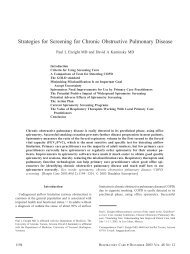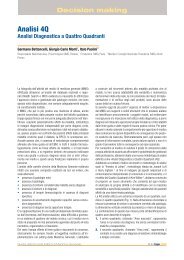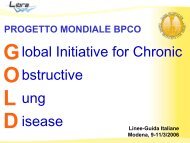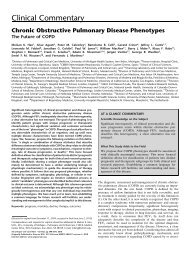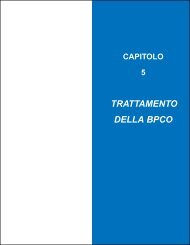Global Initiative for Chronic Obstructive Lung Disease - GOLD
Global Initiative for Chronic Obstructive Lung Disease - GOLD
Global Initiative for Chronic Obstructive Lung Disease - GOLD
You also want an ePaper? Increase the reach of your titles
YUMPU automatically turns print PDFs into web optimized ePapers that Google loves.
<strong>GOLD</strong>_WR_05 8/18/05 12:56 PM Page 21<br />
<strong>for</strong> the development of COPD is unclear. Malnutrition and<br />
weight loss can reduce respiratory muscle strength and<br />
endurance, apparently by reducing both respiratory muscle<br />
mass and the strength of the remaining muscle fibers 8 .<br />
The association of starvation and anabolic/catabolic<br />
status with the development of emphysema has been<br />
shown in experimental studies in animals 9 .<br />
HOST FACTORS<br />
Genes<br />
It is believed that many genetic factors increase (or<br />
decrease) a person's risk of developing COPD. Studies<br />
have demonstrated an increased risk of COPD within<br />
families with COPD probands. Some of this risk may be<br />
due to shared environmental factors, but several studies<br />
in diverse populations also suggest a shared genetic risk 10,11 .<br />
The genetic risk factor that is best documented is a<br />
severe hereditary deficiency of alpha-1 antitrypsin 12-14 , a<br />
major circulating inhibitor of serine proteases. This rare<br />
hereditary deficiency is a recessive trait most commonly<br />
seen in individuals of Northern European origin.<br />
Premature and accelerated development of panlobular<br />
emphysema and decline in lung function occur in both<br />
smokers and nonsmokers with the severe deficiency,<br />
although smoking increases the risk appreciably. There<br />
is considerable variation between individuals in the<br />
extent and severity of the emphysema and the rate of<br />
lung function decline. Although alpha-1 antitrypsin<br />
deficiency is relevant to only a small part of the world's<br />
population, it illustrates the interaction between host<br />
factors and environmental exposures leading to COPD.<br />
In this way, it provides a model <strong>for</strong> how other genetic risk<br />
factors are thought to contribute to COPD.<br />
Exploratory studies have revealed a number of candidate<br />
genes that may influence a person's risk of COPD,<br />
including ABO secretor status 15,16 , microsomal epoxide<br />
hydrolase 17 , glutathione S-transferase 18 , alpha-1 antichymotrypsin<br />
19 , the complement component GcG 20 , cytokine<br />
TNF- 21 , and microsatellite instability 22 . However, when<br />
several studies of a given trait are available, the results<br />
are often inconsistent. Several of these genes are<br />
thought to be involved in inflammation, and there<strong>for</strong>e are<br />
related to potential pathogenic mechanisms of COPD.<br />
Airway Hyperresponsiveness<br />
Asthma and airway hyperresponsiveness, identified as<br />
risk factors that contribute to the development of COPD,<br />
are complex disorders related to a number of genetic and<br />
environmental factors. The relationship between asthma/<br />
airway hyperresponsiveness and increased risk of<br />
developing COPD was originally described by Orie and<br />
colleagues 23 and termed the "Dutch hypothesis."<br />
Asthmatics, as a group, experience a slightly accelerated<br />
loss of lung function 24,25 compared to non-asthmatics, as<br />
do smokers with airway hyperresponsiveness compared<br />
to normal smokers 26 . How these trends are related to the<br />
development of COPD is unknown, however. Airway<br />
hyperresponsiveness may also develop after exposure to<br />
tobacco smoke or other environmental insults and thus<br />
may be a result of smoking-related airway disease.<br />
<strong>Lung</strong> Growth<br />
<strong>Lung</strong> growth is related to processes occurring during<br />
gestation, birth weight, and exposures during childhood 27-31 .<br />
Reduced maximal attained lung function (as measured by<br />
spirometry) may identify individuals who are at increased<br />
risk <strong>for</strong> the development of COPD 32 .<br />
EXPOSURES<br />
It may be helpful conceptually to think of a person's<br />
exposures in terms of his or her total burden of inhaled<br />
particles (Figure 3-2). Each type of particle, depending<br />
on its size and composition, may contribute a different<br />
weight to the risk, and the total risk will depend on the<br />
integral of the inhaled exposures. Of the many inhalational<br />
exposures that people may encounter over a lifetime, only<br />
tobacco smoke 2,33-39 and occupational dusts and chemicals<br />
(vapors, irritants, and fumes) 40,41 are known to cause<br />
COPD on their own. Tobacco smoke and occupational<br />
exposures also appear to act additively to increase a<br />
person's risk of developing COPD.<br />
Tobacco Smoke<br />
Cigarette smoking is by far the most important risk factor<br />
<strong>for</strong> COPD and the most important way that tobacco<br />
contributes to the risk of COPD. Cigarette smokers have<br />
a higher prevalence of respiratory symptoms and lung<br />
function abnormalities, a greater annual rate of decline in<br />
FEV 1 , and a greater COPD mortality rate than nonsmokers.<br />
These differences between cigarette smokers and nonsmokers<br />
increase in direct proportion to the quantity of<br />
smoking. Pipe and cigar smokers have greater COPD<br />
morbidity and mortality rates than nonsmokers, although<br />
their rates are lower than those <strong>for</strong> cigarette smokers 33 .<br />
Other types of tobacco smoking popular in various<br />
countries are also risk factors <strong>for</strong> COPD, although their<br />
risk relative to cigarette smoking has not been reported.<br />
Age at starting to smoke, total pack-years smoked, and<br />
current smoking status are predictive of COPD mortality.<br />
RISK FACTORS 21


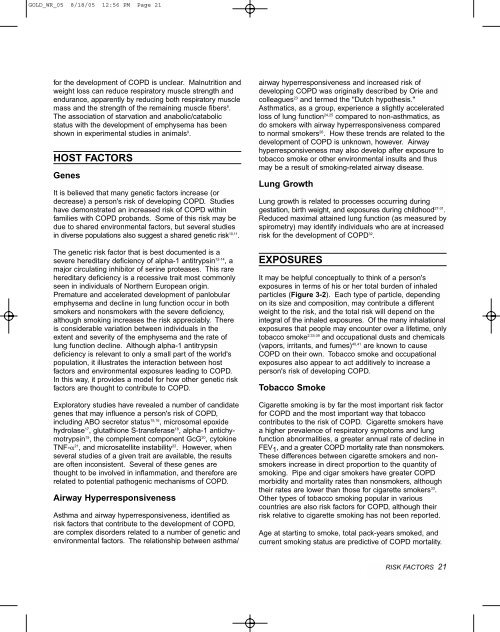

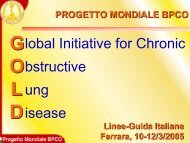
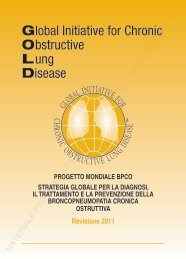
![Di Bari [NO].pdf - GOLD](https://img.yumpu.com/21544924/1/190x143/di-bari-nopdf-gold.jpg?quality=85)


